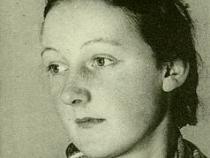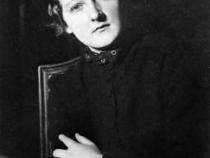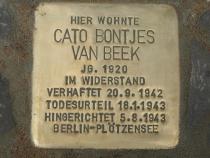Location
Kaiserdamm 22
District
Charlottenburg
Stone was laid
12 June 2009
Born
14 November 1920 in Bremen
Excecuted
05 August 1943 in Berlin-Plötzensee
Cato Bontjes van Beek was twelve years old when Hitler came to power in 1933. She had just returned home from a two-year stay with her aunt in Amsterdam, where she had learnt to speak fluent Dutch. She was glad to be back in Fischerhude at last, on the banks of the Wümme, not far from Bremen, and was respected by her peers for her boldness and spirit.
She even stood up to her teacher. The school master was exasperated by the Bontjes children, who simply refused to join the Hitler Youth. It meant that he had to give them lessons while the other children practised hoisting flags and marching in step. “You can’t always swim against the tide!” he shouted at them one day. But Cato retorted, “Yes, we can!”
Cato and her sister Mietje and brother Tim were not interested in uniforms and marches. They preferred going for hikes in the Devil’s Moor and, in summer, swimming in the Wümme River. Their appreciation of the countryside and above all their parents’ upbringing ensured they were immune to the brown disease. Their mother, Olga Bontjes van Beek, was an expressionist dancer and painter who made fun of Hitler. And all the friends who came and went at the Bontje’s home were opponents of the Nazis. These writers, artists and philosophers included Theodor Lessing, who took the children on explorations of the surrounding moors and heaths. Everyone in Fischerhude knew that the Bontjes were left-wing. Jan Bontjes van Beek, whose parents came from the Netherlands, was known to the villagers as the “red seaman”. They left him and his family and friends to do as they liked.
The 1930s were a largely carefree period for Cato. Even her parents’ divorce did not change this state of affairs much. Her father, Jan, moved to Berlin, set up a ceramics workshop and got married a second time, to an interior designer with Jewish ancestry.
In 1937 Cato spent six months as an au-pair in the south of England. The letters she sent home during this time were still light-hearted in tone. Here, she was introduced to Far Eastern philosophy by a friend and student of agriculture, John Hall. With him, she embarked on an exploration of Indian and Chinese spirituality and the world of Asian thinkers and philosophers.
In late 1937, Cato attended a commercial college in Berlin and completed an apprenticeship as a ceramicist in her father’s workshop. It was in his home in September 1940 that she met Libertas Schulze-Boysen, wife of Harro Schulze-Boysen, the head along with Arvid Harnack of the Berlin resistance group dubbed the “Red Orchestra” by the Gestapo. Through her, Cato soon met the key figures in the group, who told her about the atrocities committed by the Nazis against Poles, Russians and Ukrainians on the eastern front.
Together with her boyfriend Heinz Strelow, Cato started offering active resistance against the criminal Nazi regime. Cato and Heinz made and distributed flyers and hid persecutees, and helped French prisoners of war and Ukrainian forced labourers.
A radio message from Moscow spelt disaster for the “Red Orchestra”. It named the organization’s leading figures, and was intercepted and decoded by the German defence. In autumn 1942, the Nazis started taking steps against the group, one of the largest resistance organizations with the highest number of female members. Some 130 supporters were arrested, including Cato Bontjes van Beek. In January 1943, the Reich Military Court sentenced her and other members of the group, her friend Heinz Strelow among them, to death. Cato was subsequently held for almost ten months in various Berlin prisons before being executed on 5 August 1943 in Plötzensee. She was 22 years old.
While in prison, she developed a spiritual form of resistance. Her letters and records, as well as the testimonies of her fellow prisoners, show that the Nazi regime did not break her. “I did not beg to be allowed to live,” she wrote. She went to the scaffold calmly and upright. Her love for her family and friends and the countryside around Fischerhude sustained her spirit to the last.
She even stood up to her teacher. The school master was exasperated by the Bontjes children, who simply refused to join the Hitler Youth. It meant that he had to give them lessons while the other children practised hoisting flags and marching in step. “You can’t always swim against the tide!” he shouted at them one day. But Cato retorted, “Yes, we can!”
Cato and her sister Mietje and brother Tim were not interested in uniforms and marches. They preferred going for hikes in the Devil’s Moor and, in summer, swimming in the Wümme River. Their appreciation of the countryside and above all their parents’ upbringing ensured they were immune to the brown disease. Their mother, Olga Bontjes van Beek, was an expressionist dancer and painter who made fun of Hitler. And all the friends who came and went at the Bontje’s home were opponents of the Nazis. These writers, artists and philosophers included Theodor Lessing, who took the children on explorations of the surrounding moors and heaths. Everyone in Fischerhude knew that the Bontjes were left-wing. Jan Bontjes van Beek, whose parents came from the Netherlands, was known to the villagers as the “red seaman”. They left him and his family and friends to do as they liked.
The 1930s were a largely carefree period for Cato. Even her parents’ divorce did not change this state of affairs much. Her father, Jan, moved to Berlin, set up a ceramics workshop and got married a second time, to an interior designer with Jewish ancestry.
In 1937 Cato spent six months as an au-pair in the south of England. The letters she sent home during this time were still light-hearted in tone. Here, she was introduced to Far Eastern philosophy by a friend and student of agriculture, John Hall. With him, she embarked on an exploration of Indian and Chinese spirituality and the world of Asian thinkers and philosophers.
In late 1937, Cato attended a commercial college in Berlin and completed an apprenticeship as a ceramicist in her father’s workshop. It was in his home in September 1940 that she met Libertas Schulze-Boysen, wife of Harro Schulze-Boysen, the head along with Arvid Harnack of the Berlin resistance group dubbed the “Red Orchestra” by the Gestapo. Through her, Cato soon met the key figures in the group, who told her about the atrocities committed by the Nazis against Poles, Russians and Ukrainians on the eastern front.
Together with her boyfriend Heinz Strelow, Cato started offering active resistance against the criminal Nazi regime. Cato and Heinz made and distributed flyers and hid persecutees, and helped French prisoners of war and Ukrainian forced labourers.
A radio message from Moscow spelt disaster for the “Red Orchestra”. It named the organization’s leading figures, and was intercepted and decoded by the German defence. In autumn 1942, the Nazis started taking steps against the group, one of the largest resistance organizations with the highest number of female members. Some 130 supporters were arrested, including Cato Bontjes van Beek. In January 1943, the Reich Military Court sentenced her and other members of the group, her friend Heinz Strelow among them, to death. Cato was subsequently held for almost ten months in various Berlin prisons before being executed on 5 August 1943 in Plötzensee. She was 22 years old.
While in prison, she developed a spiritual form of resistance. Her letters and records, as well as the testimonies of her fellow prisoners, show that the Nazi regime did not break her. “I did not beg to be allowed to live,” she wrote. She went to the scaffold calmly and upright. Her love for her family and friends and the countryside around Fischerhude sustained her spirit to the last.






